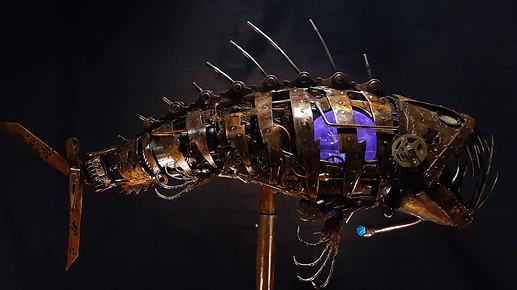What is an automaton?
So what are the differences between the metal sculptures I create that are fixed, or "static', and the automatons I create?
To answer that question, probably the easiest thing to do is to start with explaining what an automaton is.
An automaton can be one or more of several things. One definition is a moving mechanical device made in imitation of a human being (or animal). Another definition is a machine that performs a function according to a predetermined set of coded instructions. The encyclopedia Britannica defines automaton or automata, as "any of various mechanical objects that are relatively self-operating after they have been set in motion. The root meaning of the words that "automaton" is taken from is "acting of itself". (Early 17th century: via Latin from Greek}
The world's first successfully-built biomechanical automaton is considered to be The Flute Player, which could play twelve songs, made by French engineer, Jacques de Vaucanson, in 1737. However, many historical accounts indicate mechanical art and devices that were intended to entertain and amaze even emperors, kings, and queens, were around well over 1,800 years earlier. Unfortunately, few examples of automatons made prior to the 16th century remain.
Today,there is a slight overlap often with kinetic art forms, yet automata is distinct enough to still be considered it's own art form. A modern form of animating mechanical devices incorporates electronics, and is called animatronics.
MY AUTOMATONS
My sculptures sometimes combine automata with a little of animatronic techniques or electrically operated devices, but remain heavily controlled by mechanical means for the most part. I generally prefer to use rotating cams, or sprockets, connected to levers or other parts in order to move each piece in specific timing correlating to the overall movement. That's often a deeply involved process with much thought and planning required.
Something that I believe sets my work apart from most any other moving art, is that I do not use a machine shop, or CNC machine, or any other computer controlled machining tool to fabricate the levers, mechanisms, gears, etc. All of the mechanical parts that move the machine are actually other scrap or salvaged objects that I assemble to create the movements of each piece. I also do not use a CAD program or computer drawing software to calculate and test how each part will work, leverage, fulcrum, pivot points, clearances between moving parts, loads, etc. Everything I do is done with pencil and paper, or during process in my head as the creative process blends with engineering.
LEARNING THIS ART
This art often requires knowledge of electrical design, electrical engineering, automation and motor controls, electronic circuitry and logic programming, multiple welding techniques, such as TIG, MIG, and "stick" welding of various types of metals, as well as engineering and design skills in 3-dimensional construction, metallurgy, metal forging, artistic sculpture, and even chemistry that is used in treating metals and creating unique patinas and lasting finishes. It is the most demanding of all arts I have ever worked with, in part because it requires skills in so many different disciplines and the ability to get those disciplines to work together as one. Yet it is one of the most rewarding forms of art for me, as I have the privilege of activating a lifetime of multiple fields of study and practice in what I do, and all in a single creation.
ABOUT STATIC SCULPTURES
I also produce metal static sculptures and I do enjoy that discipline as well. Similar to my automatons, I create these from scrap metal objects, antique metal tools, hardware, and other fun items, often dating over a century old, forgotten, lost to time. I love taking these items, each with their hugely diverse histories, often with amazing stories, and putting them together in a harmonious way to create one beautiful form. It's a merger of multiple paths of life in one artistic creation.
The act of creating new life, new art, from abandoned found objects is a deeply satisfying way of contributing to making the earth a more beautiful place. I enjoy both, creating recycled automatons and stationary art, but I often find myself drawn to the machines more. There's really nothing like starting from a single metal object, building on with your two hands until the culmination is a creature that comes alive in front of your very eyes. I am grateful to have this opportunity!


This very complex automaton, Absolem, from Alice in Wonderland, features well over 300 moving mechanical parts, created from scrap pieces of metal objects. Movements include all 8 smaller legs in sequence, head, mouth, eyes, front two arms, and the unique character actually smokes a hookah pipe, blowing the smoke from his mouth.
Within the base, which is a large Fly Agaric variety, lives a mouse, made from a salvaged pressure dial gauge. He wears thick rim red glasses and peeps out of his front door every minute or so.
His address on the outside wall says
" 1 -8 Cheddar Lane".
.jpeg)
Dragon Automaton Breathes Smoke, moves head, mouth, tongue,wings fold, wings flap, roars, plays music and talks!


This unique 3-foot long commissioned work features binaural tuned resonating sound from either side of the sculpture, which results in a unique audio experience standing near the sculpture. Inside are many kinetic component movements that create the mechanics behind all four leg-like fin appendages, the caudal fin made from large pruning sheer blades, and spinning copper wound stator. Subtle lighting accents various areas, including the tip of it's blue glass-marbled lure, but arguably the most fascinating interior feature is the argon and neon filled plasma globe that reacts to the resonating sound and ambient sound surrounding the automaton. Thus, it hears your voice and it is reflected in the intensity of the plasma lightning effects within the sculpture.

